mercury econoline pickup
Postal Code: 95208
Search locally
-
$7.20
Ilco H75-P Blank Replacement Key Ford Mazda Mercury LincolnSacramento,CA,USA- 50mi -
$29.99
POLISHED ALUMINUM LICENSE PLATE FRAME FORD HOT ROD CUSTOM MUSCLE CAR VTG STYLESacramento,CA,USA- 50mi -
$39.99
POLISHED ALUMINUM LICENSE PLATE FRAME FORD HOT ROD CUSTOM MUSCLE CAR VTG STYLESacramento,CA,USA- 50mi -
$29.99
BLACK ANODIZED ALUMINUM LICENSE PLATE FRAME FORD HOT ROD CUSTOM MUSCLE CAR TRUCKSacramento,CA,USA- 50mi -
$24.53
YH-552 Motorcraft A/C Clutch Cycle Switch New for E150 Van E250 E350 F150 TruckSan Jose,CA,USA- 50mi -
$29.99
POLISHED ALUMINUM LICENSE PLATE FRAME FORD HOT ROD CUSTOM MUSCLE CAR VTG STYLESacramento,CA,USA- 50mi -
$2.50
Assotment of Fan Alternator Belts Fomoco and othersTruckee,CA,USA- 120mi
Learn more about mercury econoline pickup.
1965 Mercury EM-100 Econoline Pick up For Sale E100 pickup
1965 Mercury EM-100, Mercury Econoline 5 window pickup truck. For Sale rare one of a kind. Solid running easy starting 350 Olds 2bbl Tornado drive line into ...
-
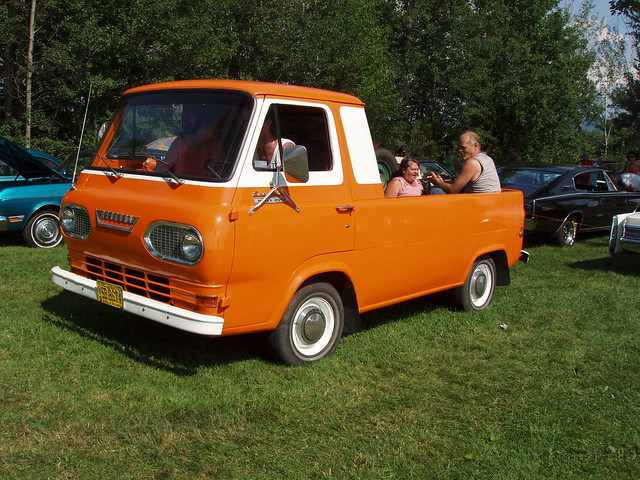
Mercury Econoline Pickup 1964
Voiçi un véhicule très rare: un Econoline Pickup, Mercury de surcroit ! Ce véhicule a fière allure dans sa belle robe orange et blanche !
Photo by marcusguay on Flickr
-
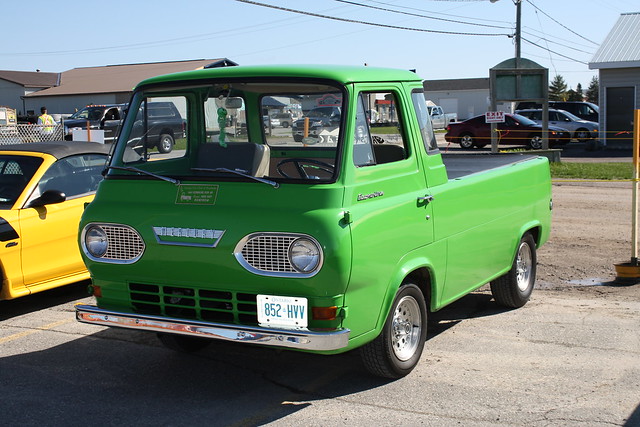
1964 Mercury Econoline pickup (Canadian)
Photo by carphoto on Flickr
-
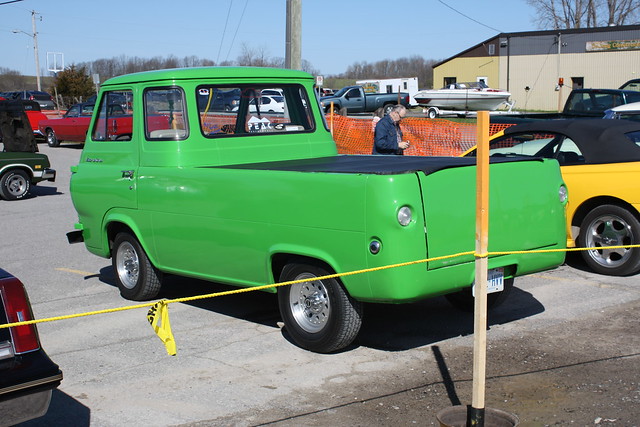
1964 Mercury Econoline pickup (Candian)
Photo by carphoto on Flickr
-
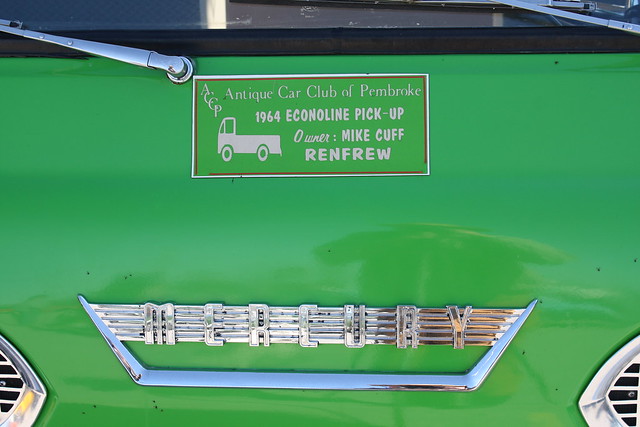
1964 Mercury Econoline pickup (Canadian)
Photo by carphoto on Flickr
-

cars_ 65 econoline pickup
What can I say? I was in a weird mood.
Photo by yes_we_do2002 on Flickr
-

1965 Mercury Econoline van
Photo by kenmojr on Flickr
-
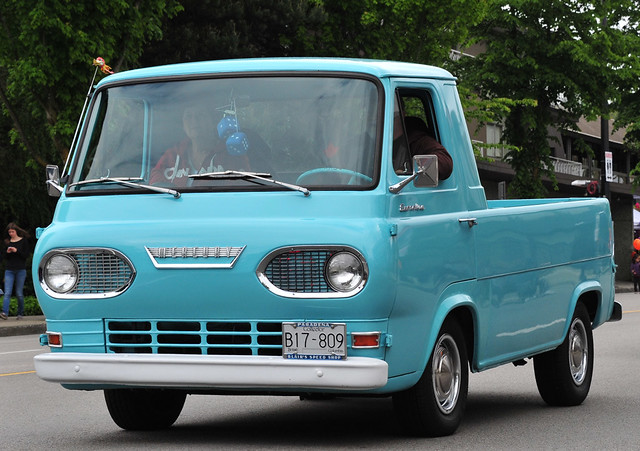
1965 Mercury Econoline
Pickup truck For a video of other vehicles in the Hats Off Show & Shine Car Show 2012 flic.kr/p/cawqN3 2012 Hats Off Day Heights North Burnaby BC Canada
Photo by D70 on Flickr
-
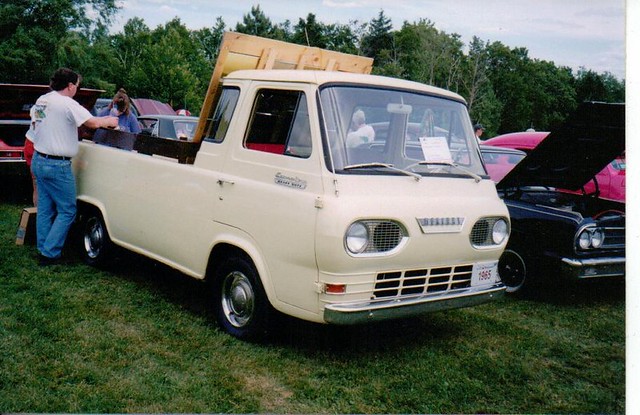
1965 Mercury Econoline pickup
The Mercury name was used on trucks only in Canada. This 1965 Mercury Econoline is seen at the Ford Country Club's annual Father's Day show in Moncton, New Brunswick, Canada, in June 1999.
Photo by JarvisEye on Flickr
-
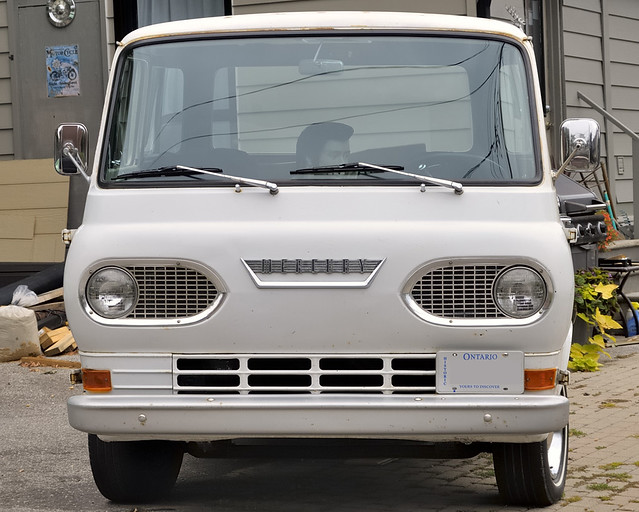
1965 Ford Mercury Econoline EM-100 pickup - Toronto Roncesvalles
_DSC8617 Anx2 1100h Q90 Ap Q10
Photo by edk7 on Flickr
-
2016 Ford F-150
07/06/15, via The Car Connection
Full-size pickup trucks like the Ford F-150—the best-selling vehicle in the U.S. for decades—have long been in virtual lock step as part of a battle for capability. In towing and payload ratings, interior space, and bad dimensions, they inch ahead
-
Sawyer Motors Car Show in Saugerties gets motors running
07/12/15, via The Daily Freeman
Brian Morris of Saugerties brought a bit of West Coast flavor to the show with his 1966 Ford Econoline van. It was tricked out with an air It's accompanied by a 1957 Mercury Camper trailer that also sits inches off the ground. The system uses an
-
Maybe Should've Mentioned This Earlier, But...
07/02/15, via The Portland Mercury (blog)
I saw two women with a fullsize pickup at a gate around the time of Kyron Horman's disappearance. Out past Banks, past the swamp, right before Hwy 6 turns into a passing lane. I was heading East down the hill and they were at the gate pointing South,
-
Top 102 Movie Cars of All Time
03/28/15, via Edmunds.com
Fast & Furious 6 (2013) Custom Ramp Car — Built by Dennis McCarthy's crew in California, it used the front suspension off a Chevy pickup, a V-Drive for the mid-mounted LS3 V8 to send power rearward, and had an appetite for Vauxhall cop cars. 96
-
Crash involving semi sends 3 to hospital
06/05/15, via KTVB
Goade failed to stop for slowing traffic and struck the rear of a 2010 Mercury Mariner, driven by Amy Jones, 50, of Meridian. - Jones' vehicle was Rist's vehicle was pushed into a 2012 Ford Econoline Van, driven by Gary Ferreira, 40, of Nampa
-
February auto sales up, but not for all
03/03/15, via USA TODAY
The full-size Transit van , introduced last year to replace most versions of the Econoline , or E-series, van, drove a 30% increase in total Ford van sales. It was Ford's best February van sales performance since 2007. • FCA: Fiat Chrysler Automobiles
-
Separate vehicle crashes in Dickinson County leave 3 injured
06/25/15, via KSN-TV
The Kansas Highway Patrol reports a Tennessee couple were injured at about 6:54 a.m. when their 2001 Lincoln Town Car headed eastbound left I-70 near mile marker 281 in Dickinson County, crossed the median and struck a 206 Mercury Montego driven by
-
 1965 Mercury Econoline PickupImage by www.flickr.com
1965 Mercury Econoline PickupImage by www.flickr.com -
 Description 1965 Mercury Econoline Pick Up.jpgImage by en.wikipedia.org
Description 1965 Mercury Econoline Pick Up.jpgImage by en.wikipedia.org -
 RARE 1965 MERCURY Econoline Pick up , built by Ford of Canada, for ...Image by car-from-uk.com
RARE 1965 MERCURY Econoline Pick up , built by Ford of Canada, for ...Image by car-from-uk.com -
 2812738730_2137abf6b9_z.jpg?zz=1Image by flickr.com
2812738730_2137abf6b9_z.jpg?zz=1Image by flickr.com -
 7327075068_71b0bb8ac1_z.jpgImage by www.flickr.com
7327075068_71b0bb8ac1_z.jpgImage by www.flickr.com -
 5679034179_0dd5571039_z.jpgImage by flickr.com
5679034179_0dd5571039_z.jpgImage by flickr.com -
 3502339955_32a5cf8642_z.jpgImage by www.flickr.com
3502339955_32a5cf8642_z.jpgImage by www.flickr.com -
 2903416458_ecc3b8ab21_z.jpgImage by flickr.com
2903416458_ecc3b8ab21_z.jpgImage by flickr.com -
 RARE 1965 MERCURY Econoline Pick up , built by Ford of Canada,, US $ ...Image by www.2040cars.com
RARE 1965 MERCURY Econoline Pick up , built by Ford of Canada,, US $ ...Image by www.2040cars.com
Maybe Should've Mentioned This Earlier, But... - The Portland Mercury (blog)
I saw two women with a fullsize pickup at a gate around the time of Kyron Horman's disappearance. Out past Banks, past the swamp, right before Hwy 6 turns into a passing lane. Source: www.portlandmercury.com
Crash involving semi sends 3 to hospital - KTVB
BOISE - Idaho State Police are investigating a crash on westbound I-184 at the Flying Wye, near the westbound Milwaukee onramp. Goade failed to stop for slowing traffic and struck the rear of a 2010 Mercury Mariner, driven by Amy Jones, 50, of Meridian. - Jones' vehicle was pushed into a 2007 Nissan Versa, driven by Susan Graham, 27, of Boise. - Graham's vehicle was pushed into a 2001 Ford Focus, driven by Kenneth Rist, 60, of Lafayette, Colorado. - Rist's vehicle was pushed into a 2012 Ford Econoline Van, driven by Gary Ferreira, 40, of Nampa. Graham, her passenger Bryan Graham, 27, of Boise, and Jones were transported by ground ambulance to Saint Alphonsus Regional Medical Center in Boise. Source: www.ktvb.com
February auto sales up, but not for all - USA TODAY
Monthly auto sales were up, but not for all automakers and not as much as some industry watchers forecast. One jarring note: Toyota Motor outsold Ford Motor by 84 vehicles to take the No. 2 spot, behind General Motors. Toyota's SUV sales rose significantly, while Ford's overall sales fell because it hasn't yet gotten production of the redesigned F-150 pickup up to speed at the Kansas City Assembly Plant. Ahead of the sales reports, most forecasts were set for an annual pace of 16. 7 million. With automakers that account for most sales reporting, the estimate slid as low as 16. 2 million. Slow February, slow year is the fear. Among the domestic makers, General Motors and FCA — Fiat Chrysler Automobiles — reported increases, while Ford dropped slightly on lack of full F-150 production. Overall, GM truck sales rocketed 36% ahead of last year. At FCA, Jeep SUV brand continued to be the headliner — up 21. 1% for its best month ever. In spite of some soft sales totals — Ford and Volkswagen among them — TrueCar. com says the month is evidence that the "renaissance in the U. S. auto sector continues into February. Source: www.usatoday.com
-
Huge Selection of Fords
at Performance Ford in Randolph, NJ Test Drive a Ford Transit Connect!
-
Ford E-Series - Wikipedia, the free encyclopedia
Ford E-Series
 Overview
Manufacturer
Ford
Production
1961–present (limited as of 2015, only stripped chassis and cutaway produced)
Model years
1961–present
Assembly
Lorain, Ohio, United States (until plant closure)Avon Lake, Ohio, United StatesOakville, Canada[1]Nanchang, China
Body and chassis
Class
Full-size van
Chronology
Successor
Ford Transit (United States & Canada)
Overview
Manufacturer
Ford
Production
1961–present (limited as of 2015, only stripped chassis and cutaway produced)
Model years
1961–present
Assembly
Lorain, Ohio, United States (until plant closure)Avon Lake, Ohio, United StatesOakville, Canada[1]Nanchang, China
Body and chassis
Class
Full-size van
Chronology
Successor
Ford Transit (United States & Canada)
The Ford E-Series, also known as the Ford Econoline in Mexico and Ford Club Wagon, is a line of full-size vans (both cargo and passenger) and truck chassis from the Ford. The line was introduced in 1961 as a compact van and its descendants are still produced today, though they are scheduled for replacement by the Ford Transit.
Though the E-Series has been its own unique platform since 1968, it uses many components from the F-Series line of pickup trucks. The Econoline is manufactured solely at Ford's Ohio Assembly plant in Avon Lake, Ohio—after the closure of the Lorain, Ohio plant in December 2005 and the consolidation of all production at Avon Lake. As of 2012, the E-Series and the Transit Connect compact MPV (which debuted for the 2010 model year) are the only vans in the Ford lineup in North America.
Since 1980, E-Series has been the best selling American full-sized van, and held 79.6% of the full-size van market in the United States in 2007, with 168,722 vehicles sold.[2]
The E-series is a tow vehicle, due to the available GCWR (Gross Combined Weight Rating) of up to 20,000 lb (9076 kg), and its relatively low curb weight.[3]
Ninety-five percent of van sales are to commercial or fleet-end users; about half are cargo vans. The E-Series cargo area features a double-wall design which leaves the exterior sheet metal less vulnerable to damage from shifting cargo.[4]
In early 2007, the E-Series was listed by Autodata as one of the top 20 best-selling vehicles in the United States, most likely due to fleet sales. In China, the Ford E-Series (E250 and E350) are manufactured by Jiangling Motors with Ford name plates. As of 2014, the Ford E-Series is sold in North America, the Middle East, and China in LHD only. It has recently been discontinued in Mexico.
Contents
1 First Generation 1961–1967 2 Second Generation 1968–1974 3 Third Generation 1975–1991 4 Fourth Generation 1992–2007 4.1 1997 4.2 1999–2002 4.3 2001 E-Series 4.4 2003 facelift 5 Fifth Generation 2008–present 6 Sales 7 Phaseout 8 See also 9 References 10 External links First Generation 1961–1967[edit] Ford E-Series
1961–1967 Ford Econoline (customized)
Overview Also called Ford Falcon Club WagonMercury Econoline (Canada) Production 1961–1967 Body and chassis Body style 3-door van2-door pickup truck Layout FMR layout Related Ford Falcon Powertrain Engine 144 cid Falcon Six I6170 cid Thriftpower Six I6240 cid I6 Transmission 3-speed manual Dimensions Wheelbase 90.0 in (2,286.0 mm)[5] Width 75.0 in (1,905.0 mm)[5] Height 76.9 in (1,953.3 mm)[5]Based on the compact Ford Falcon, the first Ford Econoline was introduced for the 1961 model year. Sized roughly to compete with the Chevrolet Corvair 95 (Greenbrier Sportswagon) and Volkswagen Type 2, which was 172.3 in (4,376 mm) long. It was originally offered as a cargo van, an eight-passenger van with three rows of seats (which carried the Ford Falcon name) and as a pickup truck. A 165 lb (75 kg) counterweight was fitted over the rear wheels to balance the front-heavy vehicle; this was sometimes removed by later owners. The implementation of situating the driver on top of the front axle with the engine near the front wheels is called, in the US, a "cab over" short for cab over engine configuration. In Europe it is called a "forward control" vehicle. The body styling borrowed heavily from the, smaller, UK produced, Thames 400E which had been in production since 1957 and the 1956-64 Jeep Forward Control.
Instead of the rear-mounted engine used by Volkswagen and Chevrolet, the first E-Series had a flat nose with the engine between and behind the front seats. Early models had a 144 CID inline 6-cylinder engine with a three-speed manual transmission. Later models had a 170 CID or 240 CID engines with a three-speed manual or automatic transmission. It was an immediate success with utilities like the Bell Telephone System.
In its first year, 29,932 standard vans, 6,571 custom Econoline buses, 11,893 standard pickups and 3,000 custom pickups were made. The success of the Econoline led to its layout adopted in 1964 by the Chevrolet Van/GMC Handi-Van and Dodge A100; it would also be utilized internationally and sold by Mitsubishi, Nissan, and Toyota, with microvans called the Subaru Sambar and the Daihatsu Hijet.
Mercury Econoline[edit]In rural Canada, where automobile dealers were scarce, the Econoline was sold as a Mercury alongside the M-Series truck lineup. Only the first generation of Econolines were sold as Mercurys; the next van sold by the division would be the 1993 Villager minivan.
First Generation Models 1961–1967
1961–1967 Econoline with camper conversion

1961–1967 Econoline with camper conversion, rear view
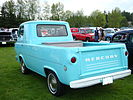
1965 Mercury Econoline pickup, rear view
Second Generation 1968–1974[edit]![[icon]](https://upload.wikimedia.org/wikipedia/commons/thumb/1/1c/Wiki_letter_w_cropped.svg/20px-Wiki_letter_w_cropped.svg.png) This section requires expansion. (December 2011)
Second Generation
This section requires expansion. (December 2011)
Second Generation
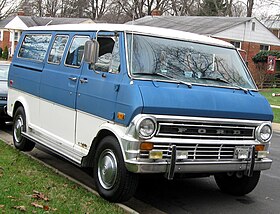
1972–1974 Ford Club Wagon
Overview Production 1968–1974 Body and chassis Body style 3-door van Layout FR layout Powertrain Engine 240 CID (3.9 L) I6300 CID (4.9 L) I6302 CID (4.9 L) Windsor V8 Transmission 3-Speed ManualCruise-O-Matic Dimensions Wheelbase SWB: 105.5 in (2,679.7 mm)LWB: 123.5 in (3,136.9 mm)Technically, Ford would not produce the Econoline for the 1968 model year. A United Auto Workers strike delayed the production of the redesigned model into late-spring 1968, delaying its introduction into the 1969 model year.
The redesigned 1969 Econoline would mark a major change for van design in North America. In a major shift from the Volkswagen-inspired cabover configuration seen before, the front axle was repositioned at the front end of the van; the "Twin I-Beam" front suspension was carried over from the F-Series trucks. Shedding its Falcon roots, the Econoline moved the engine forward of the driver, allowing for the use of heavier-duty powertrains, including the first V8 engines.
Over the next six years, the Big Three would all redesign their vans in a similar fashion. The Volkswagen-style mid-engine cabover configurations of the 1960s gave way to vans with engines in the front with a short hood. The shared components for full-size vans also switched from compact cars to full-size pickup trucks.
These were the first vans used as the basis for the now-popular Class C van-based recreational vehicles (RV), a class still dominated by Ford.
For 1971, the grille was redesigned, and a year later E-Series offered a new feature, and a new model. Sliding rear doors were an option for 1972, as well as the Hi-Cube van, the first van with a stripped chassis used for something other than recreational vehicles.
ChateauThe top trim package Club Chateau was introduced with this generation, consisting of houndstooth fabric on all seats, air conditioning, AM-FM stereo, and the ability to accommodate up to 12 passengers.
Second Generation Models 1969–1974
1969-70 Econoline Window Van

1969-70 Econoline Window Van with U.S. Army markings

1971 Econoline motorhome conversion
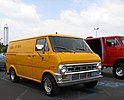

1974 Ford Econoline E-300 Quadravan
Third Generation 1975–1991[edit] Third Generation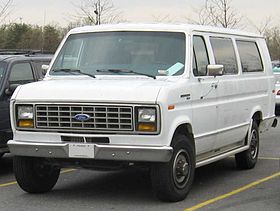
1983–1991 Ford Club Wagon
Overview Also called Ford Club Wagon Production 1975–1991 Body and chassis Body style 3-door van Layout FR layout Platform Ford VN platform Related Ford Carousel Powertrain Engine 240CI300 CID I6302 CID Windsor V8351 CID Windsor V8460 CID 385 V86.9 L Navistar diesel V87.3 L Navistar diesel V8 Transmission 3-speed manual4-speed manual3-speed automatic4-speed automaticFor the 1975 model year, the Econoline was given a ground-up redesign using an all-new platform. To improve interior room and engine access over both its predecessor and its competition, the engine was moved further forward; the hood was lengthened and flattened. A higher degree of parts commonality with the F-Series made itself known in the bodystyling: the vent windows, taillights, and wheels were common items between the two vehicles. In 1978, much of the Econoline's front end design would appear on the Transit Mk. 2.
Inside, the drivers' compartment was redesigned with more ergonomic controls, many common with the F-Series. The Econoline was available in two wheelbases and three body lengths. In a massive growth spurt, the short-wheelbase model was 0.5 inches longer than the previous long-wheelbase model; the standard Econoline sported a 138-inch wheelbase, the longest until 1990.
Passenger vans (Econoline Wagons/Club Wagons) could seat between two and 12 passengers, depending on the number of seats installed; standard-length wagons typically held two bench seats behind the driver. In 1978, a 15-passenger "Super Wagon" was introduced on the same wheelbase as the standard-length van, using a body extension added to the rear of the vehicle.
With a full frame, its chassis could now be used for cutaway vans, the basis of buses, trucks, and ambulances. This was also the beginning of aftermarket four wheel drive conversions for the van.
For sixteen years, this generation of the Econoline would continue nearly unchanged over its entire production run. In 1979, a minor facelift added a new front grille; square headlights replaced the round units. In 1983, Ford's "Blue Oval" logo was integrated into the front grille. Van conversions became a popular alternative to sparse factory passenger accommodations. For the 1988 model year, the short-wheelbase (124-inch) bodystyle was discontinued, leaving the 138-inch wheelbase as standard. Both the 3- and 4-speed manual transmissions were discontinued for 1988 as well.
Although the 1986 Aerostar minivan would introduce styling far different from the Econoline, the basic styling of the full-size van would heavily influence the Ford Ranger (and its SUV offspring, the Ford Bronco II). A stillborn variant of the Econoline, the Ford Carousel, was planned for a 1975-1976 introduction. A potential predecessor to modern minivans, the Carousel was discontinued due to lack of funding.
Third Generation Models 1975–1991
1975 Econoline 150 Chateau
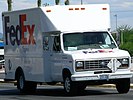

Mid 1980s Econoline 150 conversion van
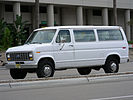

Ford Econoline 150 camper wagon
1975–1991 Ford E-Series Dimensions[6] 124" WB 138" WB (Standard Van) 138" WB (Super Van) Length 186.8 in (4,745 mm) 206.8 in (5,253 mm) 226.8 in (5,761 mm) Wheelbase 124 in (3,149.6 mm) 138 in (3,505.2 mm) Height 79.1–79.9 in (2,009.1–2,029.5 mm) 79.2–84.4 in (2,011.7–2,143.8 mm) 80.9–84.8 in (2,054.9–2,153.9 mm) Width 79.9 in (2,029 mm) Fourth Generation 1992–2007[edit] Fourth generation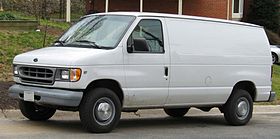
1997–2002 Ford Econoline
Overview Also called Ford Econoline (until 2006; name still used in Mexico according to Ford Mexico's website)Ford Club Wagon (until 1998)Ford Econoline Wagon (1999–2005) Production 1991–2007 Model years 1992–2007 Body and chassis Body style 3/4-door van Layout FR layout Platform Ford VN platform Powertrain Engine 300 CID 4.9 L inline-6302 CID 5.0 L Windsor V8351 CID 5.8 L Windsor V8460 CID 7.5 L 385 V8444 CID 7.3 L IH IDI Diesel V8444 CID 7.3 L Power Stroke Diesel V8256 CID 4.2 L Essex V6281 CID 4.6 L Triton V8330 CID 5.4 L Triton V8413 CID 6.8 L Triton V10365 CID 6.0 L Power Stroke Diesel V8 Transmission 4-speed automatic with overdrive or AOD5-speed TorqShift automatic Dimensions Wheelbase 138 in (3,505 mm) Length 1992–2008Regular: 212 in (5,385 mm)Extended: 232 in (5,893 mm)2009–Regular: 216.7 in (5,504 mm)Extended: 236.7 in (6,012 mm) Width 79.3–79.9 in (2,014–2,029 mm) Height 80.7–84.1 in (2,050–2,136 mm) Curb weight 4,773 lb (2,165 kg)For the first time in 17 years, the E-Series underwent an exterior redesign for the 1992 model year. A far more aerodynamic exterior was used over the same platform architecture. As before, the powertrain consisted of a 4.9 L inline six, 5.0, 5.8, and 7.5 liter V8 engines, or a 7.3 L diesel V8. Inside, an all-new drivers' compartment allowed for more room for drivers and improved ergonomics. On all models except the Econoline 350, the steering wheel was now equipped with an airbag; this was a first for a full-size van. The consumer-oriented Chateau Club Wagon version was Motor Trend magazine's Truck of the Year for 1992. While all 1992–1993 model year Econoline vans equipped with air-conditioning used R-12 Freon, Ford began using CFC-free R134a refrigerant in 1994 models beginning in late summer or early fall of 1993. The Econoline received a CFC-free air-conditioning system in September 1993, or earlier. The same is true for all 1994 Ford trucks and SUVs, including the Bronco, F-series, Ranger, and Explorer.
The only visible exterior change for 1995 was the deletion of the amber turn signals in the tail lights, used from 1992 to 1994 model years. In Canada, the Econoline name was dropped in favor of E-Series (this remained in the United States until 2002).
1997[edit]A major change of the engine lineup was made in 1997; only the 7.3 L diesel remained from the year before. A 4.2 L Essex V6 replaced the 300 inline-6 and the 7.5 L/460 V8 was replaced by a 6.8 L Triton V10. The 5.0L/302 and 5.8L/351 Windsor V8s were replaced by 4.6 L and 5.4 L Triton V8s, respectively. The Econoline received an updated front end with a new grille that featured an oval cutout and new lower front bumper trim. Inside, an ergonomic dashboard layout containing dual airbags was introduced.
1999–2002[edit]For the 1999 model year the Club Wagon full-size passenger van was renamed the Econoline Wagon. The cargo van iteration remained being called Econoline.
2001 E-Series[edit]Along with a minor update, 2001 brought a major change to the Ford full-size van lineup; the Econoline and Econoline Wagon names were discontinued. For the first time on all models, the "E-Series" name replaced Econoline, and was sold as such in the literature on commercial vans and ambulance packages, another category dominated by Ford. Heavy-duty cutaway van models, most often used in large box vans and Class C recreational vehicles, also featured "E-350" or "E-450" badging on the front fenders.
To replace the Club/Econoline Wagon (and the previous Chateau models), Ford introduced E-150 Traveler model targeted at families. The Traveler would be a short-lived model, however, as minivans and SUVs were by this point far more popular for passenger use. But as full-size vans had the towing and payload (and optional diesel power) of full-sized pickups and room for eight to 15 passengers plus their baggage, a certain segment of customers continued to buy the E-Series (and, to a lesser extent, its competitors from GM and Chrysler).
2003 facelift[edit]For 2003, Ford updated the E-Series by enlarging the grille; the Ford logo also shifted from the hood to the grille. A new engine cover, cup holder, and glove box was also added.
The year 2007 saw the replacement of the 7.3 L Power Stroke diesel and the introduction of the new 6.0 L Power Stroke with more power than the 7.3, but still detuned from the same engine in the F-Series due to a lack of airflow in the engine compartment. The 6.0 Powerstroke is intercooled, however, the 7.3 L lacked an intercooler.
Inside, a new gauge cluster was also added; it included a tachometer along with a digital odometer.
In 2006, the 6.8 L Triton V10 produced 305 hp (227 kW; 309 PS) and 420 lb·ft (569 N·m) torque, 235/440 for the diesel.
A hydrogen-fueled version of this engine powers an E-450 shuttle bus produced since 2007, used first in airports in Vancouver, British Columbia and Orlando, Florida.[7]
Fourth generation Ford E-Series / Econoline models (1997-2005)
A circa 1992–1994 Ford Club Wagon passenger van, from Maryland. This particular version can seat up to fifteen passengers.

A circa 1997–2000 Ford Econoline cargo van, from Maryland.

A circa 1995–1996 Ford E-350 school bus from Quebec, Canada. The body is manufactured by the Corbeil Bus Corporation.

A 2002 E-350 Box Truck outfitted as a disaster restoration vehicle from Bennington, New Hampshire
A circa 2003–2005 Ford E-350 cutaway box truck van, from Quebec, Canada.
Fifth Generation 2008–present[edit] Fifth generation
2009–2011 Ford Econoline
Overview Production 2007–present Model years 2008–present Body and chassis Body style 3/4-door van Layout FR layout Platform Ford VN platform Powertrain Engine Triton V8365 CID 6.0 L Power Stroke Diesel V8 Transmission 5-speed TorqShift automatic Dimensions Length 2008–Regular: 216.7 in (5,504 mm)Extended: 236.7 in (6,012 mm) Width 79.3–79.9 in (2,014–2,029 mm) Height 80.7–84.1 in (2,050–2,136 mm) Curb weight 4,773 lb (2,165 kg)Ford introduced the new E-Series at the New York Auto Show in March 2007. The van received completely redesigned front end sheet metal similar to that of the 2008 Ford Super Duty trucks. It has been overhauled with better handling and more payload.[8]
Updates to the front end of the van include larger headlights, a larger grille, and a longer hood than previously used on E-Series and Econoline vans. The 6.0 L turbo diesel is retained on the E-Series, while Super Duty received the new 6.4 L twin turbo diesel. Gasoline engines carried over. A series of upgrades to the braking, suspension and steering systems have resulted in improvements in ride and handling, braking performance and load carrying capability, although the Twin-I-Beam front suspension remains. Four-wheel drive is available through Ford Fleet Truck using current model year Super Duty parts.
The chassis and suspension improvements have also resulted in an increase in the maximum gross vehicle weight rating (GVWR) from 14,050 lb (6373 kg) to a class-leading 14,500 lb (6577 kg). Additionally, the maximum front gross axle weight rating (GAWR) is increased by about 10 percent, from 4,600 lb (2087 kg) to a class-leading 5,000 lb (2268 kg).
In 2009 the E-Series received a new dashboard, complete with Ford's new Sync system, available in-dash navigation and upfitter switches as used in the F-Series Super Duty trucks. Also included is a passenger-side glove compartment, a first for the E-Series; previously, the glove compartment was integrated in the engine cover. Another new 2009 option was the rear-view backup camera, which is becoming widely available throughout the industry on smaller vehicles; it is another first for Ford in the full-size van field. Ford is the first automotive manufacturer to offer a full-size van that is capable of using E85; this option is most commonly available on Ford's F-150 with the 5.4 L engine. It was available on the 2009 4.6 L and 5.4 L engines.
The 6.0 diesel was discontinued at the end of the 2010 model year. There was no diesel replacement for the 6.0 and the 6.8L V10 takes its place in the engine line up. Ford did not offer the new 6.7 diesel found in Super Duty trucks due to space limitations.[9] It is unconfirmed whether this means it physically does not fit or there is not enough space to cool properly.
To celebrate its half-century mark, the E-Series featured a Special 50th Anniversary version for the 2011 model year.[10] GCWR of the E450 has been raised to 22,000 lb (9979 kg), up from 20,000 lb (9072 kg).[11]
While the van variant of the E-Series stopped production after the 2014 model year due to poor sales, the stripped chassis and cutaway models continue to be produced for 2015 and will be built "until the end of the decade" due to record sales.[12]
Fifth generation Ford E-Series / Econoline models (2008–2014)
A circa 2008 Ford E-Series passenger wagon, photographed in College Park, Maryland.

A circa 2010 Ford E-450 powered by compressed natural gas, used as public transportation in Atlantic City, New Jersey.

A 2014 model year E350 "Cutaway" featuring a contractors type body manufactured by Rockport.
Calendar Year US sales 1997 186,690[13] 1998 206,026[14] 1999 202,024[15] 2000 187,027 2001 159,565 2002 165,085[16] 2003 161,721 2004 171,017[17] 2005 179,543 2006 180,457 2007 168,722 2008 124,596 2009 85,735 2010 108,258 2011 116,874 2012 122,423 2013 125,356[18] 2014 103,263[19] Phaseout[edit] 2015 Ford Transit 150 Wagon (standard roof and wheelbase)
2015 Ford Transit 150 Wagon (standard roof and wheelbase)
For the 2015 model year, passenger and cargo versions of the E-Series/Econoline were discontinued, replaced by the Ford Transit, produced by Kansas City Assembly in Claycomo, Missouri. Due to the market commonality of the E-Series, stripped chassis and cutaway cab models are still produced alongside the commercial versions of the Transit. Ford will continue production of the E-Series for commercial users through the 2015 model year and and possibly until “the end of the decade”.[12]
Along with significant gains in interior space, flexibility, and fuel economy, the decision to replace the E-Series with the Transit is part of the Ford movement to consolidate its product lines globally, as it has done with the Ford Fiesta, Ford Focus/Ford C-Max, Ford Fusion/Ford Mondeo, the Ford Escape/Ford Kuga, and the Ford Transit Connect. The Transit is the first full-size truck to utilize Kinetic Design for its styling.
See also[edit] References[edit] ^ -
Ford Econoline Pickup: Trucks For Sale, Parts, History ...
Welcome to FordEconolinePickup.com the ultimate website dedicated to vintage and iconic Ford Econoline Pickup. We are the central hub online for information, classifieds and resources about this classic truck.
Our Mission
We have several distinct goals with this website. Listed below are the resources and information we aim to provide here:
Central source for info, specs, tech data and related materials Aggregator of United States Craigslist classified ads along with links to other ad directories Place for sellers of Econoline Pickups to list their vehicles Site for potential buyers to see various trucks available for sale Research / data point for both buyers and sellers to see pricing Hub for resources including forums, parts and other content sites Comprehensive provider of truck history collaborated by top online sources including HowStuffWorks & The Truth About Cars About the Ford Econoline PickupThese original E-Series flat nose trucks were only built from 1961 to 1967. The Econoline Pickup was a 2 door variation of the 1st Generation Ford and Mercury Econoline 3-dr vans. Unlike VW and Chevy; Ford placed the engine between and behind the front seats. In the first year of production early 15,000 pickups were made and sold. Its early success led to adoption from competitors including the classic Dodge A100 van and pickup models.
Vehicle Features / SpecificationsListed below are the original stock specifications for the 1961-1967 Ford Econoline Pickup. As this truck is often modified by car enthusiast; if you are in the market for a used one you are likely to find different configurations.
Production Years: 1961, 1962, 1963, 1964, 1965, 1966, 1967 Related Vehicle: Ford Falcon Body Style: 3-Door Pickup Truck Layout: Front mid-engine, rear-wheel-drive / cab over (US) or forward control (Europe) Engines: 144 cid Falcon Six I6 (Early Models) / 170 cid Thriftpower Six I6 & 240 cid I6 (Later Models) Transmissions: 3-Speed Manual (Late models had automatic) Dimensional Specs
Wheelbase – 90.0in
Width – 75.0 in
Height – 76.9 in
Curb Weight – 2,500 lbs
Dimensional Specs
Wheelbase – 90.0in
Width – 75.0 in
Height – 76.9 in
Curb Weight – 2,500 lbs
To learn more about the Ford Econoline pickup truck check out our History page.
Visitor FeedbackWe have recently launched this website and welcome the feedback of our visitors. Our goal is to make this site the ultimate resource for information about the Ford Econoline Pickup. We also aim to be a central hub for everything classic E100 truck related along with a place to see Econoline Pickups for sale across the US.
We welcome the feedback of visitors to this site for how we can improve it and make the viewing experience better. Rather you are a casual viewer or an Econoline Pickup enthusiast we would love to hear from you. Please send us a message on our Contact page. Please include “Website Feedback” in the subject line. Thank you for helping us to improve the use of this website.
Website Disclaimer – FordEconolinePickup.com Truck SalesOne of the functions of FordEconolinePickup.com is to provide reposts along with original ads for Ford Econoline Pickups. We focus on reposting Craigslist ads from across the United States. We do this as a convenience for our visitors so that they can see all current Ford Econoline Pickups for sale in one place. We also allow users of this site to post their own trucks for sale
Please note that this website is not directly involved in the sale of any vehicle listed here. Furthermore, this site and its owners/operators are not responsible for the information posted or reposted here. It is the responsibility of the buyer and seller to perform their own due diligence before conducting any financial transaction. FordEconolinePickup.com is not responsible for any damages that should arise through the use of this site.
Sold ListingsOne of our goals is to be a research site for buyers and sellers to see the past Ford Econoline Pickups for sale in various states, cities and regions across the United States. We want users to be able to see past truck sales prices along with features, pictures, etc. For this reason we do not remove old ad posts. We do however do our best to mark these old ads as sold. However because of our own personal bandwidth along with the nature of ad expiration on Craigslist, we only do this when the seller contacts us directly.
If you are the seller of a Ford Econoline Pickup listed on this site and would like your contact information removed along with the vehicle marked as sold, please send us a message. Be sure to use the subject line “Sold Listing” to expedite the process.
Copyright UseFordEconolinePickup.com is not endorsed by the Dodge marque which is a division of Chrysler Group LLC owned by automaker Fiat. Additionally this site is not affiliated with Craigslist, eBay or any other classified ad site which content has been reformatted and republished here. The use of the Dodge name and other trademarks is done so in compliance with the Fair Use clause of US Copyright Law. All trademarks and copyrighted materials belong to their respective owners.
Images used on this site are both from various online sources including classified sites. No images on this site are owned by FordEconolinePickup.com and all rights are reserved by respective owners. If you are the owner of an image featured on this and would like it removed, please contact us.
Content Accuracy, Timeliness and AvailabilityThe information presented on this site is not guaranteed to be complete, accurate or up-to-date. Additionally while we do our best to update this site regularly there is no guarantee of this or the continued operation of the site. Please contact us should you have any questions about this.

-
1965 Mercury EM-100 Econoline Pick up For Sale E100 pickup
Rating is available when the video has been rented.
This feature is not available right now. Please try again later.
Uploaded on Feb 3, 2012
1965 Mercury EM-100, Mercury Econoline 5 window pickup truck. For Sale rare one of a kind. Solid running easy starting 350 Olds 2bbl Tornado drive line into 9"Ford rear end can launch front end. 1966 Ford van roof for a custom tonneau cover on rollers. Clean custom mid 80's Honda interior 70,000 km automatic, gasoline. Body is ruff in places but all glass is clean and none broken. $3000.00 o.b.o. Can make arrangements to deliver. Lots of extras email ecosteve@rogers.com Ad is posted here on kijiji, video posted here on Youtube http://youtu.be/FcvB1yNLSsc photos are hosted at http://www.flickr.com/photos/eco-steve/
Show more Show less
-
1965 MERCURY Econoline Pickup Truck
1965 MERCURY Econoline Pickup Truck

Click Here To Read About The Muscle Car That Got Away
1965 MERCURY Econoline Pickup TruckIts a rare low production numbers pick up 1 of 1291 BuiltIts has been verified by both Ford of Canada and Ford USA.Click Here To See Documentation LetterIt currently has a 302 Motor with GT-40 Heads, Crane 294 Cam,OEM Shelby Intake, 600 BP HolleyRoller rockers, Alum WP,Macs equal length headers,new radiator,C-6 Narrow Case Transmission,9" Rear.NO body mods, except for spray in bed liner.Truck runs well.It's not a show piece, it's a street cruiser.It is NOT exactly a user friendly thing to drive,it's rough, it's hot and it's 1965 steering and brakes {all new}BUT, it looks and sounds COOLFord has verified that there were only 1291 of these built.Mercury trucks were ONLY available in Canada.Truck is currently in heated storage in Canada.It has not seen snow since I found it over a decade ago.Price: I need $13,500 for it andI can help with any export/import paperwork and cross border brokerage.More Information Contact R K Dickie atEmail: rkdickie@yahoo.com Ortext 1-956-560-9034 till mid April or1-204-522-5106 after mid April. Click Here for a detailed Inspection Report on this vehicle
 More Collector Mercury/Mercury Street Rods For Sale
More Collector Mercury/Mercury Street Rods For Sale
 HOME
HOME

-
Mercury Truck History | Mercury Pickup
Badge-engineering More Brands For A Smaller Market
If you lived near the Canadian border during the 1940s, ’50s, or ’60s, you might remember Ford and Mercury sheet metal, wearing the Meteor or Monarch name plates. Ford trucks were also badge-engineered and sold as Mercury trucks.
As a point of history, Ford was in business in Windsor, Ontario by 1904, a year after the Ford Motor Co. was founded on the other side of the Detroit River.
The Meteor, Monarch cars and Mercury trucks first appeared in April, 1946 because of Ford of Canada’s postwar marketing strategy. More lower-priced cars were sold in Canada than in the United States because of the slightly lower standard of living, not to mention whopping sales and excise taxes that added almost 20 percent to the sticker prices across the border.
To give the Canadian Lincoln-Mercury dealers a broader range of cars that reached into the low-price market, they sold the Meteor, a Mercury-ized Ford. To counter any sales advantage from Lincoln-Mercury dealers’ broader range, Ford dealers got the upscale Monarch, a Mercury clone. Because smaller Canadian towns had either a Ford-Monarch or Lincoln-Mercury-Meteor dealer, but not both, the L-M-M network got the Mercury truck.
Canadian-made Ford and Mercury trucks differed, for the most part, only cosmetically. Many years it was just “Mercury” versus “Ford” letters on the hoods and pickup tailgates, plus distinctive medallions that set them apart. Often there was a bit more glitz on the Mercury trucks, in keeping with their slightly-more-upscale image. As far as the dash plastic molding in 48-50, only the Mercury had a kind of gray marble look, where Ford was tan in color. But occasionally there were distinctly-different grille layouts. For instance, like the American-built Ford trucks, Ford of Canada’s 1946-47 pickups were warmed-over pre-war models, but the Mercury trucks were treated to a heavily-chromed grille and bumper treatment, compared to the Ford’s plain looks.
Ford’s first all-new postwar vehicle was a truck and not a car. Ford trucks got all-new sheet metal for 1948. Ford, Mercury, Lincoln…. and in Canada, Meteor and Monarch…. cars were all-new for model year 1949. Incidentally, while the new Monarch name plate appeared in 1946, the Meteor debuted in 1949. Before that, Canadian L-M dealers sold a Mercury-based Mercury 118 (for its 118-inch wheel base) and a Ford-based Mercury 114 (for the Ford’s 114-inch wheel base.)
In 1948, Ford (USA) introduced the F-1, F-2, F-3, etc. truck nomenclature. Ford of Canada took a modified tact. It used an “M” for the Mercury, in the place of the “F,” but the numeral stood for the truck’s Gross Vehicle Weight rating, less the zeros. Thus, a Mercury M-68-designated 6800 pound GVW-corresponded to a Canadian Ford F-68. It got back in step in 1953 when Ford switched to the current F-100, F-250, F-350 numbering scheme with parallel M-100, M-250, M-350 designations for the Mercury.
The mechanicals of both Canadian built truck brands were virtually identical. Because of a smaller Canadian market, (Ford of Canada roughly sold one-tenth as many trucks as its US parent). Canadian buyers had a smaller menu to choose from in terms of models, ratings and power-plants. While American Fords got an all-new overhead valve V8 in 1954, the venerable flathead V8 soldiered on for another year in Canadian Fords, Meteors, and Mercury trucks. Until 1956, only V8 engines were installed in all Canadian Ford cars and trucks, since no six-cylinder Ford engines were produced in Canada until the 223- cid six appeared in 1956.
Ford’s other commercial-oriented vehicles were also disguised a bit when they showed up in Lincoln-Mercury-Meteor showrooms. For years, Ford offered car-based sedan deliveries, called the Courier. There were Meteor versions as well. When the Ranchero pickup car debuted in 1957, a Meteor Ranchero was offered in Canada and would be for several years.
The need for a dual marketing network was eliminated with the Automotive Trade Agreement signed by the United States and Canada in 1965. The free-flow across the border brought the phase-out of the Mercury trucks by March 23, 1968. In the interim, vehicles like the Mercury ME-100 Econoline vans, pickups and mini buses were produced in Lorain, Ohio. The Ontario Truck Plant sent some of its product to the Northeast United States. Of course they wore the Ford rather than Mercury logos.
This setup was not unique to Ford. Pontiac dealers in Canada sold lower-priced Pontiacs that were essentially Chevrolets with Pontiac styling features. Canadian Dodge-DeSoto dealers offered a Plymouth based Dodge model and Chrysler-Plymouth dealers sold Fargo trucks that followed the cloning philosophy of the Ford-built Mercury trucks.

-
Mercury M-Series - Wikipedia, the free encyclopedia
Mercury M-Series

Unrestored 1949 Mercury M47 ½ Ton
Overview Manufacturer Mercury (Ford) Production 1946–1968 Body and chassis Class Full-size pickup truck Layout Front engine, rear-wheel driveFront engine, four-wheel drive Chronology Successor Ford F-Series (1967–1972)The Mercury M-Series is a pickup truck that was produced between 1946 and 1968 by Mercury, primarily for the Canadian market. Early versions often came with a higher output (CM-1 designated) Mercury/Ford flathead V8 engine over and above the unique Mercury-specific grille, badging and trim that adorned every Mercury M-Series truck.
The M-Series was introduced in Canada because smaller communities either had a Ford dealer or a Lincoln-Mercury-Meteor dealer, but not both; a Mercury truck line offered more opportunities for truck sales.
Contents
1 Pickup Trucks 2 Other Mercury Trucks 3 See also 4 External links Pickup Trucks[edit]
Between 1948 and 1968 Ford of Canada used the "F" prefix for Ford and "M" for Mercury. From 1948-1950 nominal tonnage ratings were replaced by a series designation in which the numbers indicate the GVWR when equipped with tires of appropriate capacity. Each code number is arrived at by dividing the GVWR of the series by 100. Thus an F-47 (M-47) indicates a GVWR of 4700 lbs. per axle or 9400 lbs. total for front and rear axles combined, F-135 (M-135) indicates 13500 lbs., etc. Each truck series is rated to its GVWR. In 1951-52 Ford of Canada got back in step with Ford USA with F-1 (M-1), F-2 (M-2) etc. (GVWR = Gross Vehicle Weight Rating - weight of chassis, cab and body, plus payload)
Other Mercury Trucks[edit] 1965 Mercury Econoline EM-100 pickup
1965 Mercury Econoline EM-100 pickup
Alongside the re-badged Ford F-Series pickup trucks, Mercury sold its own versions of the Ford medium-duty trucks, the B-Series bus chassis, and the C-Series cabover. The first generation of the Ford Econoline was also available as a Mercury. Similarly, the first generation Ford Ranchero was also sold under the Meteor marque in Canada.
See also[edit] Wikimedia Commons has media related to Mercury M-Series.
Ford F-Series
Mercury (automobile)
Ford flathead V8 engine
External links[edit]
Wikimedia Commons has media related to Mercury M-Series.
Ford F-Series
Mercury (automobile)
Ford flathead V8 engine
External links[edit]
http://www.fordification.com/forum/viewtopic.php?f=2&t=35331
Mercury, a division of Ford Motor Company, 1939–2011 Final models(2010-2011) Grand Marquis Mariner Mariner Hybrid Milan Milan Hybrid Historic models Bobcat Brougham Capri Colony Park Comet Commuter Custom Cougar Cyclone Eight LN7 Lynx M-Series Marauder Marquis Medalist Meteor Monarch Montclair Montego Monterey (car) Monterey (mini-van) Mountaineer Mystique Park Lane Brougham S-55 Sable Topaz Tracer Turnpike Cruiser Villager Voyager Zephyr Concept cars Messenger Meta One My XM-800
-
Junkyard Find: 1972 Ford Econoline 300 Camper Van
12/02/14, via Truth About CarsAfter yesterday’s 1972 Mercury Junkyard Find, it makes sense— in some circles— to stick with model-year 1972 vehicles this week. With that in mind, here’s a very biohazardous second-gen Ford Econoline that I braved without benefit of a space suit.
-
Ford Cars
07/11/14, via AutomotiveFord followed up on the Model T’s success by acquiring Lincoln Motor Company in 1925. Ford used the Lincoln brand to expand into the luxury car market just as it began using the Mercury marque ... vehicle is the Ford F-150 truck. As a full-size pickup ...
-
Project Car Hell: Off-brand postwar pickups edition: 1946 Hudson or 1947 Mercury?
11/30/12, via Automotive NewsYour Hell Project postwar truck will need to be something a little more unusual ... That means that you can find all manner of mirror-world versions of Ford trucks up there, e.g., Mercury Econoline vans and Mercury M-100 trucks. Well, actually, you ...
-
Project Car Hell: Off-brand postwar pickups edition: 1946 Hudson or 1947 Mercury?: Hauling molten metal in the beds of two orphan half-tons
11/28/12, via Auto WeekProper rear-drive pickup trucks can be as ... north-of-the-border postwar trucks with Mercury badging. That means that you can find all manner of mirror-world versions of Ford trucks up there, e.g., Mercury Econoline vans and Mercury M-100 trucks.
-
Ford E-Series: Requiem for the Band Van
12/09/11, via New York Times Blogswhen its front fascia received the Built Ford Tough grille treatment also worn by the F-Series pickup truck. The early Econoline van, which made a cameo in Neil Young’s “Tonight’s the Night,” was built “more to capture a spirit of the times than ...
-
Rollover Alert: Feds Extend Warning About Large Passenger Vans
10/14/10, via The Car ConnectionThese vans, which include long versions of the Chevrolet Express, GMC Savana or Ford Econoline or Club Wagon, along with discontinued models like the Rally/Vandura or Dodge Ram Van, have a body-on-frame configuration that creates a higher center of gravity ...
-
Ford's E-Series Vans Celebrate 50 Years of Success; 2011 Lineup Features Special Anniversary Edition
09/12/10, via The Auto ChanelIn fact, MOTOR TREND magazine named the 1992 Ford Econoline Chateau Club Wagon its Truck of the Year ... the company's automotive brands include Ford, Lincoln and Mercury, production of which has been announced by the company to be ending in the fourth ...
OEM Style Ford Diesel Glow Plug Relay Solenoid 6.9L & 7.3L Powerstroke, Turbo, 1985-2003 E-Series Econoline E250 E350 Van, F-Series Pickups 1994 95 96 97 98 99 00-2003 F250 F350 F450 F550 F650 F750, 2001-2003 Excursion, with International IHC T444E Review
OEM Style Ford Diesel Glow Plug Relay Solenoid 6.9L & 7.3L Powerstroke, Turbo, 1985-2003 E-Series Econoline E250 E350 Van, F-Series Pickups 1994 95 96 97 98 99 00-2003 F250 F350 F450 F550 F650 F750, 2001-2003 Excursion, with International IHC T444E Reviewhttp://tinyurl.com/leu7euz OEM Style Ford Diesel Glow Plug Relay Solenoid 6.9L & 7.3L Powerstroke, Turbo, 1985-2003 E-Series Econoline E250 E350 Van, F-Series Pickups 1994 95 96 97 98 99 00-2003 F250 F350 F450 F550 F650 F750, 2001-2003...
Featured Products
Free shipping
- Designed to meet or exceed OE specifications in form, fit and function
- The pickup coil generates a voltage that is sent to the ICM...
- Brand new OEM direct replacement pickup
- Reduces common ignition coil/spark plug issues such as; no/hard...
- ENA Ignition Coils Kits are engineered for original equipment and...
- 1 Year Limited Warranty - Please use Amazon's Your Garage feature...
Free shipping
- ???? COMPABILITY-Starter for Lincoln Mark Series 1993-1998 4.6L...
- ???? INTERCHANGEABILITY-F2VY-11002-A, F2VY-11002-ARM,...
- ???? GUARANTEE-One year warranty
Free shipping
- Replacement for P/N: CWTWB1U345, CWTWB1U331, CWTWB1U212, GQ43VT11T
- fits Ford, Lincoln, Mercury, Mazda F150 F250 F350 Escape Expedition...
- User programmable with provided step-by-step instructions
Free shipping
- Advanced filtration technology and superior filtration performance
- Warranted to be free from defects and are fully compatible with...
- New vehicle manufacturer warranties remain in full effect when...
Free shipping
- ✔ Replace These OEM's: ARROWHEAD SFD0100, J&N 410-14075, LESTER...
- ✔1-yr hassle-free Warranty. Active customer support.
- ✔ 12V Starter Motor "without Drive Bendix" for Ford 1962 1963 1964
Free shipping
- ▲Compatible OEM part number of this oxygen sensor is 15717 15716...
- ▲1 year warranty! <b>▲DOICOO brand genuine quality▲ Free and easy...
- ▲Your encouraging good review will be appreciated and will help...
Free shipping
- We use copper wire with wonderful electrical conductivity to ensure...
- Lifetime Warranty
- Please use amazon's part finder filter or check the detailed...
- A high quality, Direct Fit OE Replacement EGR Line Fitting from...
- EGR tube to exhaust manifold
- FREE 1-year UNLIMITED mileage warranty coverage on Evan-Fischer...


.JPG/220px-'49_Mercury_M-Series_(Auto_classique_Salaberry-De-Valleyfield_'11).JPG)










